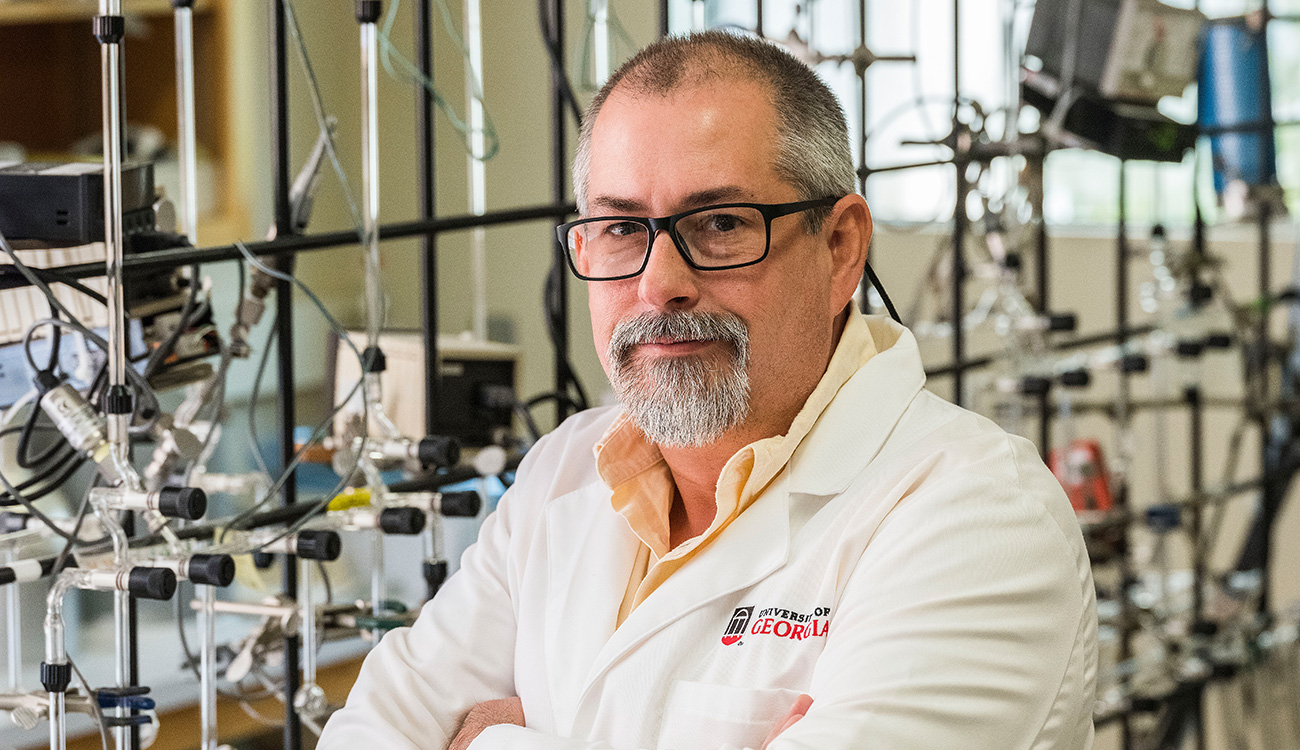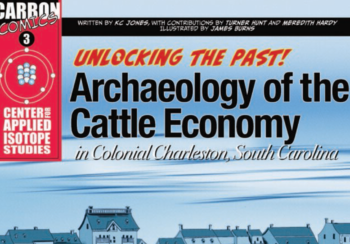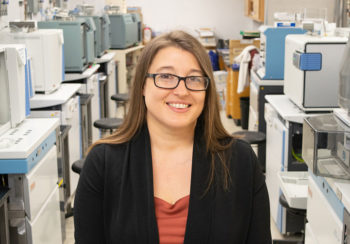You probably don’t want to test Jeff Speakman’s diagnostic skills.
The archaeologist and director of UGA’s Center for Applied Isotope Studies has many tools in his arsenal and plenty of experience, so you’d better come with a challenge—as one student discovered recently.
After returning from the Cook Islands, the student brought Speakman a tourist item made of basalt and asked a question: Where did it come from? Basalt is a volcanic material with properties similar to obsidian—volcanic glass—which Speakman has studied for years. Speakman identified not just which of the 15 Cook Islands the item came from, but also which part of the island.
The student’s response? “You’re absolutely right.”
To be fair, it’s not easy to stump Speakman. He and the CAIS team have been working as scientific detectives for years, conducting investigations on behalf of industry partners, universities, government agencies and researchers, including UGA faculty and students. Their many projects include testing hide, hair and bone collagen from a 36,000-year-old mummified Alaska steppe bison; authenticating samples of consumer products like honey, champagne and vanilla; and analyzing a skull presumed to be from a Civil War soldier.
“Thematically, the center is about measuring isotopes,” Speakman says. “CAIS is the largest stable isotope laboratory in the world, and one of the most comprehensive geochemistry laboratories in the world.”
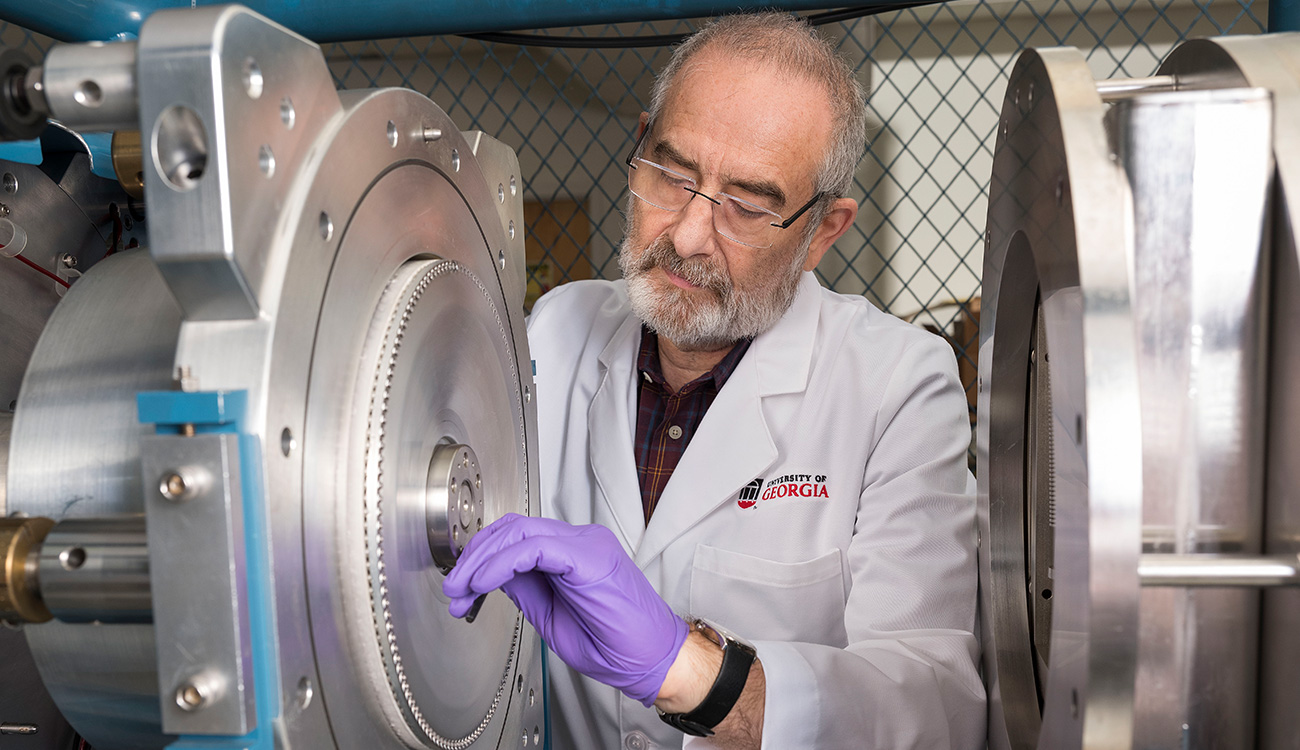
In spring 2014, a skull was scheduled to be auctioned in Hagerstown, Maryland. It had been found on a farm about two miles north of Gettysburg, Pennsylvania, near a barn that served as a field hospital during the Battle of Gettysburg in July 1863. But public reaction to auctioning a soldier’s remains was strongly negative, and the skull was withdrawn and donated to the Gettysburg Foundation.
The foundation planned a soldier’s burial for the skull, but first they turned to the Smithsonian for verification. Based on its appearance, Smithsonian anthropologists immediately suspected that the skull was far older than presumed and sent a tiny piece of tooth to CAIS for testing. Using radiocarbon dating, Speakman discovered that the skull was about seven centuries old. Carbon and nitrogen isotope testing suggested that the “soldier” ate a diet of mainly corn, and based on oxygen isotopes, he probably originated in southwestern New Mexico or southeastern Arizona.
“Oxygen is a really good indicator of temperature. As you move farther north, water evaporates differently,” Speakman says. “By looking at isotopic ratios of oxygen, we can identify northern and southern movement.”
This kind of expertise is why the Smithsonian brought its question to UGA. In its earliest iteration, CAIS was known as the Geochronology Laboratory, founded in 1968. It focused primarily on radiocarbon dating, working on marine-based research like sediment mapping in rivers and harbors. In the 1980s the stable isotope lab was established and focused mainly on the authentication of natural materials and food ingredients, an aspect of the lab’s work that continues to thrive.
Speakman joined CAIS in 2011—from the Smithsonian—and became director the next year. In 2016, the center expanded its physical footprint to 24,000 square feet and also enhanced its capabilities. When Speakman arrived, CAIS had three instruments capable of measuring stable isotopes, and now it has 22, more than any other lab in the world. The staff has nearly quadrupled in that same period, growing from 13 people to around 50. About 20 percent of those are scientists, who have their own research projects and often are affiliated with other campus departments, and the rest are postdocs, students and support staff.
The lab now measures carbon, nitrogen, oxygen, deuterium and sulfur isotopic signatures in environmental and biological samples. This information can be used to track animal migration patterns and ocean temperatures, help reconstruct ecosystems, monitor pollution or test products’ authenticity. In addition to radiocarbon dating and stable isotope analysis, CAIS researchers perform tests including elemental analysis, bio-based product testing, natural product authenticity, and organic and inorganic analyses.
The center is one of UGA’s core research facilities, serving needs on and off campus. Since 2012, CAIS has conducted research for more than 450 universities, government agencies, nonprofits and industry clients, as well as hundreds of campus-based researchers, processing more than 1,000 analytical requests from UGA faculty and students. In 2015 alone, the center analyzed approximately 68,000 samples, with the stable isotope lab processing about 75 percent of those.
“On average, our growth has increased 10 percent per year for the last decade,” Speakman says.
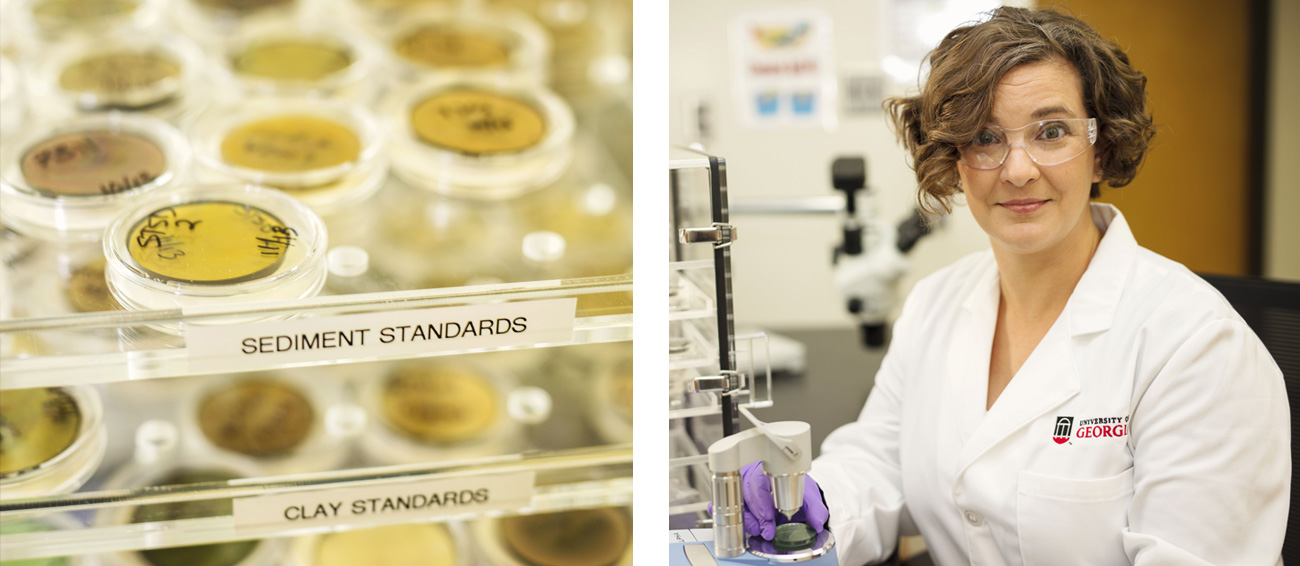
Alice Hunt used to have a sign on her door that read: “Empowering the scientist in everyone.”
The CAIS assistant research scientist has always been passionate about empowering others. Before starting graduate school, she served as a humanitarian aid worker in Bosnia-Herzegovina. After arriving at the center as a postdoc in 2013, she conducted science-related outreach and education activities in the Athens community in her free time. When Speakman found out, he encouraged her to make it part of her job.
“As a center within the university, we should be doing education and outreach not only to our students but also to the community,” he says.
Hunt focuses primarily on two audiences, pre-K through 12th grade and undergraduate students, sometimes working directly with students and sometimes providing resources for teachers. For example, Hunt wrote a curriculum for high school on dropping the A-bomb and radioactive decay.
“Not every teacher is comfortable leading a class on radiation physics,” she says.
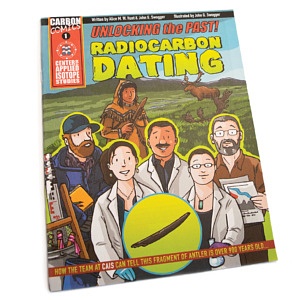
Hunt also spearheaded the creation of a bilingual English/Spanish comic book series. The first issue covered radiocarbon dating; Hunt wrote a curriculum to accompany it and is working with the Georgia Department of Education to make it available statewide.
The second comic book, out this fall, explores archaeometallurgy through a project identifying the origin of mission bells. In the Southeast, mission bells were used at Spanish settlements in places like St. Catherines Island, Georgia, and sites in Florida. During indigenous uprisings, the bells—whose ringing was a reminder of subjugation under Spanish rule—often were torn down, broken into pieces and given out like party favors.
Using x-ray fluorescence and lead isotopes—via the only MC-ICPMS (multicollector inductively coupled plasma mass spectrometer) machine in the state—to examine samples of the mission bells, CAIS scientists were able to confirm where they were founded.
“Despite what the mission records say about these bells coming from Spain, some came from Mexico,” Hunt says.
In addition to projects at the state level, Hunt continues her work in the local community. During the summer she worked with the Louis Stokes Alliance for Minority Participation on a program that gave guidance for how to be a STEM major in college, exploring questions like: How do you study? What are career choices other than doctor? What’s the difference between working in a service lab and a research lab?
At the college level, Hunt serves on UGA’s STEM core courses working group. Collaborating with an interdisciplinary team, she designed a suite of interventions to help students taking freshman chemistry—typically a tough experience. The program of interventions was tested this spring, and 82 percent of students in the test section earned a C or above, compared to about 65 percent for other sections.
With the STEM on the Move program, Hunt helps integrate technology into a course with the goal of improving STEM literacy. During fall 2017 she worked with Cynthia Camp, associate professor of English literature, on the Hargrett Hours Project, a student-led research project into a 15th-century “Book of Hours” (a type of Christian text popular in the Middle Ages) held at UGA’s Hargrett Rare Book and Manuscript Library. Students first learned the skills necessary to engage in basic manuscript study and then applied those skills, using portable x-ray fluorescence to analyze medieval pigments from the Book of Hours with the help of Hunt and CAIS.
Hunt is full of ideas, like starting a book club for STEM majors. The sign on her door is long gone, but she’s still trying to help people find their inner scientist.
“That’s what gets me out of bed in the morning,” she says.
Things are not always what they seem.
Take, for example, the box of shrunken heads that arrived at CAIS in 2014. They were sent by a museum that wanted to know how old the heads were—information that would determine whether they could be moved across state lines, according to laws governing the transport of human remains. After radiocarbon dating, CAIS determined that some of the heads were modern, and close visual inspection suggested that some were not actually human.
Randy Culp, associate director of CAIS, is very familiar with the ways in which appearances can be misleading. He leads the center’s natural products and bio-based products testing, which uses radiocarbon and stable isotope analytical techniques to authenticate natural products in foods, flavors and beverages.
Associate Director Randy Culp leads CAIS testing for natural products and bio-based products—he sometimes refers to it as “forensics in food and flavor authenticity.”
Some natural compounds can be synthesized cheaply in a laboratory, so it’s tempting to substitute synthetic compounds for natural, plant-derived compounds, increasing the profit margin for a manufacturer. That makes it important to confirm the authenticity of commercial consumer products, particularly those labeled “all natural.” CAIS has been doing that for more than 30 years; during the last 10 years, the same analytical techniques also have been applied to bio-based products, which are commercial or industrial products not used for food and feed.
CAIS has tested products like champagne, honey, curcumin and vanilla—one of the most popular flavoring products in the world. U.S. Food and Drug Administration rules dictate that vanilla labeled as natural must come from vanilla beans, Culp says, although the average grocery store shelf will contain large quantities of products claiming to be natural vanilla.
“There’s not enough natural vanilla grown in the world to supply that, so it has to come from some other source,” he says.
If Speakman and the CAIS staff can be considered scientific detectives, then Culp and his team are the forensics branch of the operation. They work with individual companies but also government agencies to determine if what’s on the label matches what’s inside the package. They use a variety of methods, including radiocarbon dating, which measures the amount of carbon-14 present. All living plants and anything derived from plants have a certain amount of carbon-14, so its absence indicates that a product was synthesized from something else—probably a petrochemical product—instead of plants.
It’s a constant game of cat and mouse to keep up with those trying to evade regulations.
“I’ve often said, ‘The bad guys know what we can do,’” Culp says. “They figure out something to circumvent a test, and we have to figure out what we can add to our arsenal of isotopes or elemental analysis to reveal what they have done.”
To get a head start, CAIS has worked with the Flavor and Extract Manufacturers Association to develop databases profiling compounds that they commonly test.
“We know what these compounds look like when they’re natural, and we know what they look like when they’re synthetic. This way we’ve got a better handle on assigning the source or the process for these particular samples,” he says.
In 2014, CAIS became ISO/IEC 17025 accredited to conduct stable isotope and radiocarbon analyses. It’s kind of like the Good Housekeeping Seal for labs, according to Culp. CAIS is also one of two labs in the U.S. that are certified by the American Society for Testing and Materials International to determine whether bio-based products meet USDA standards.
“Authenticity testing is building. There are a lot more products that are being advertised as natural, and that means there’s a lot more scrutiny, so our business is increasing quite a bit,” Culp says. “We want to make sure we do it right.”
If you visit CAIS, you might overhear an interesting comment like, “Well, it’s a weird piece of bone.”
The speaker might be referring to a sample from one of the center’s many clients, who come from all over the world. Or it could be a UGA-based researcher discussing his or her own project. CAIS works with a number of UGA scientists—both faculty and graduate students—on a variety of projects.
Scott Noakes, an associate research scientist who leads the center’s scientific diving program, is investigating lionfish, an invasive species that is destroying natural habitats in the Gulf of Mexico and off the Atlantic coast. Ph.D. student Kat Napora is exploring samples of trees pulled for duck pond maintenance on an island in Georgia’s Altamaha River, so far finding trees ranging in age from a few decades to 6,000 years, providing a chronology of environmental change. In June, professor of archaeology Victor Thompson published research revealing the site of the Native American Calusa tribe’s king’s house at Mound Key, Florida—a discovery supported by tests performed at CAIS.
Testing a high volume of samples in a wide variety of fields—ecology, chemistry, biology, anthropology, marine science, geology, physics, plant science, horticulture and forestry—requires a significant investment in equipment.
“CAIS is one of about five universities in the country that have a compact accelerator for measuring carbon-14,” Speakman says. “Even fewer universities have two accelerators.”
It also requires anticipating future needs. Speakman is making plans to buy a third accelerator within a few years.
“We’re reaching capacity for the first two,” he says. “We need it.”



